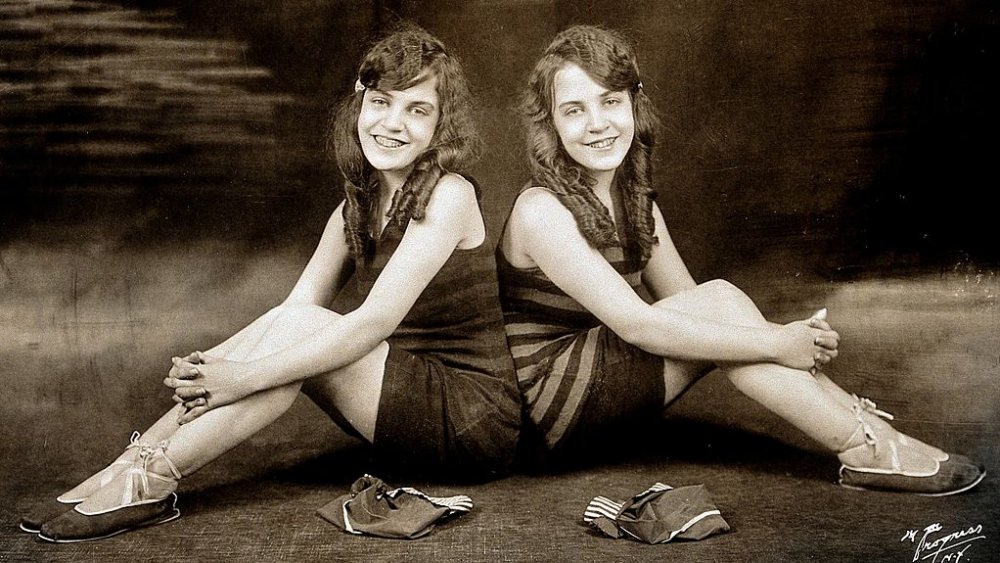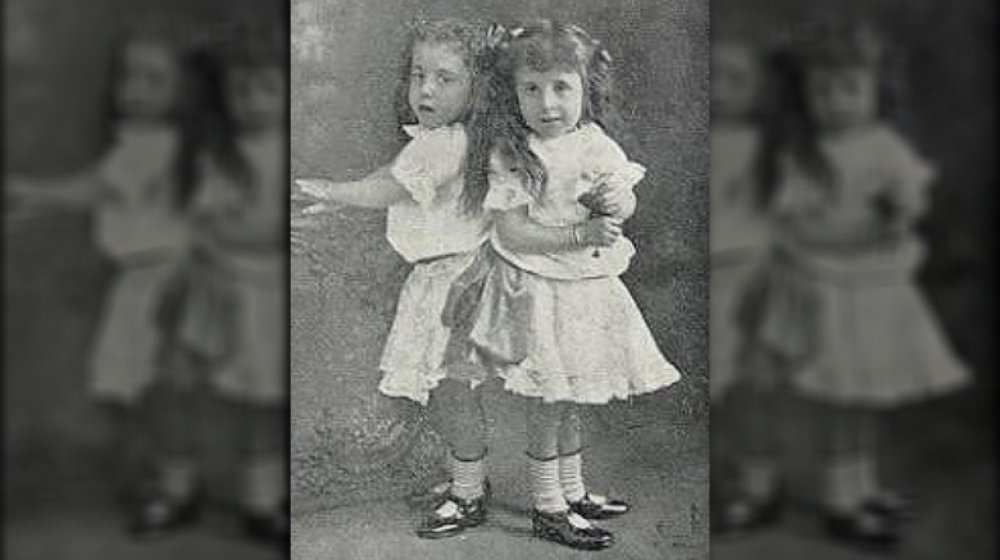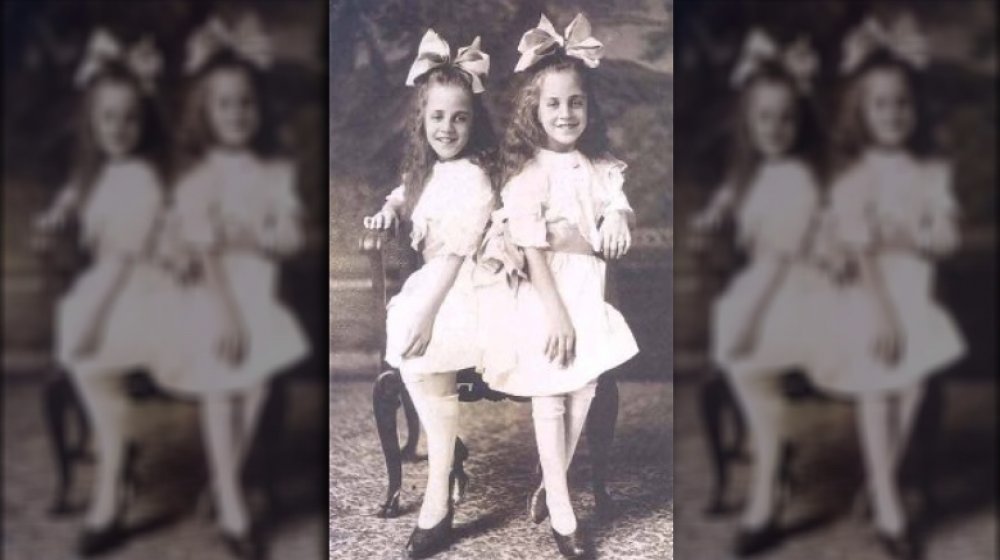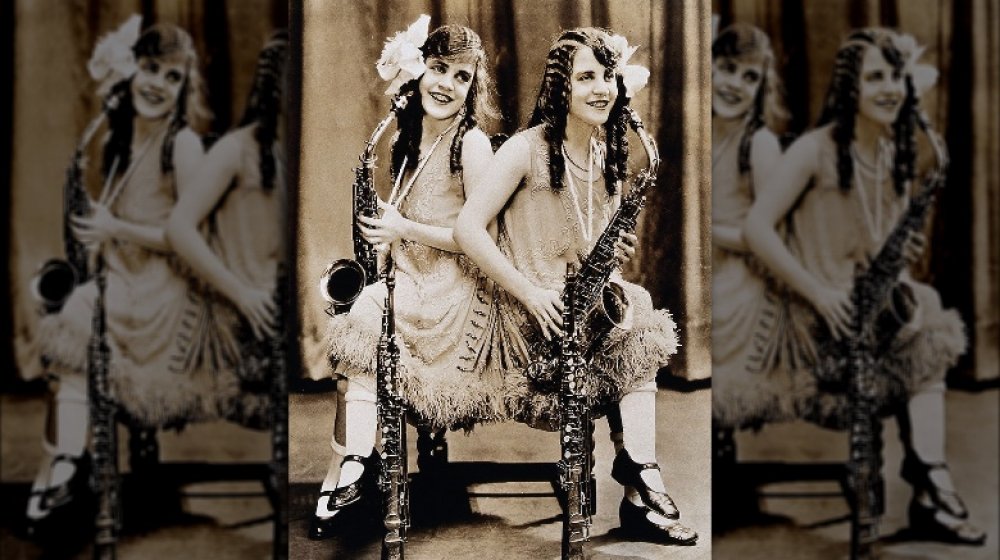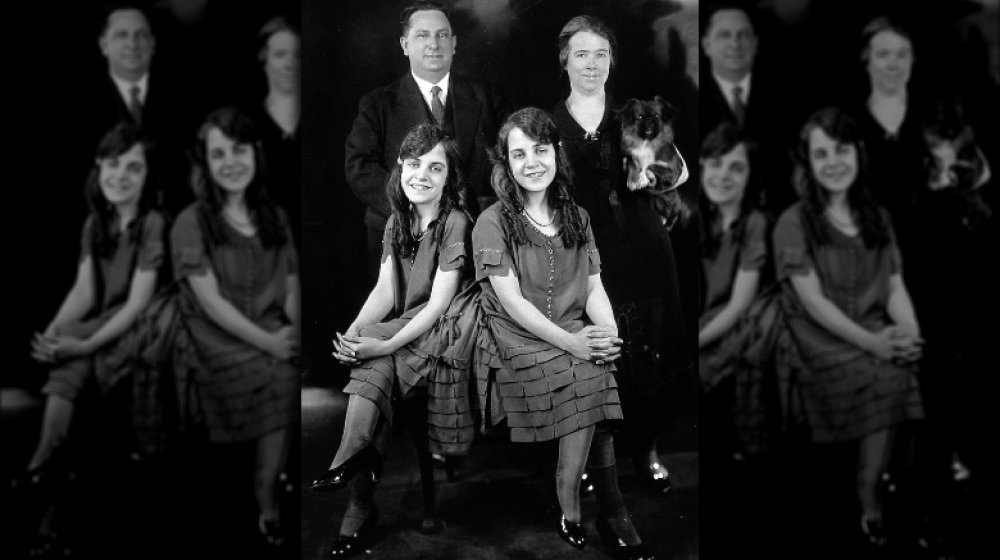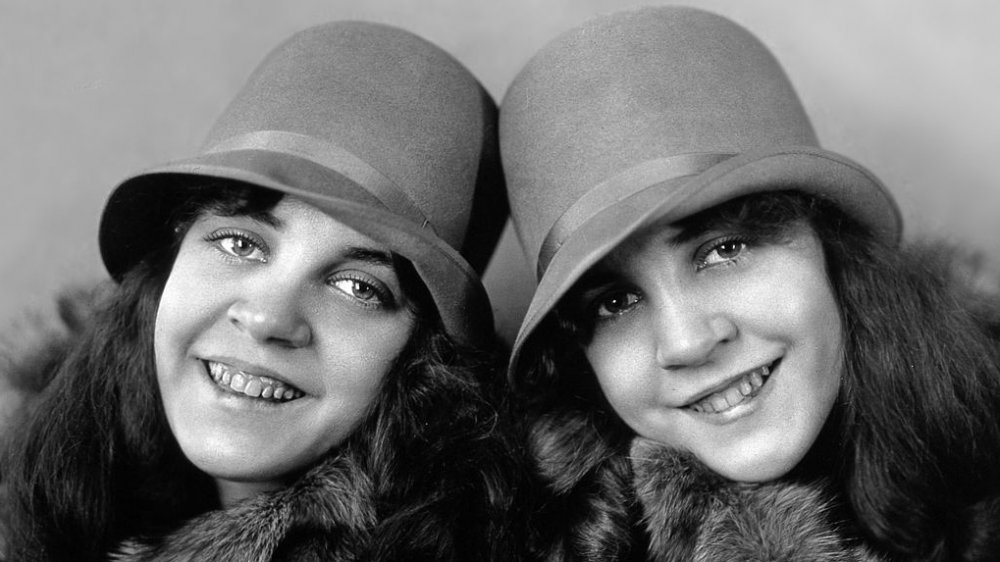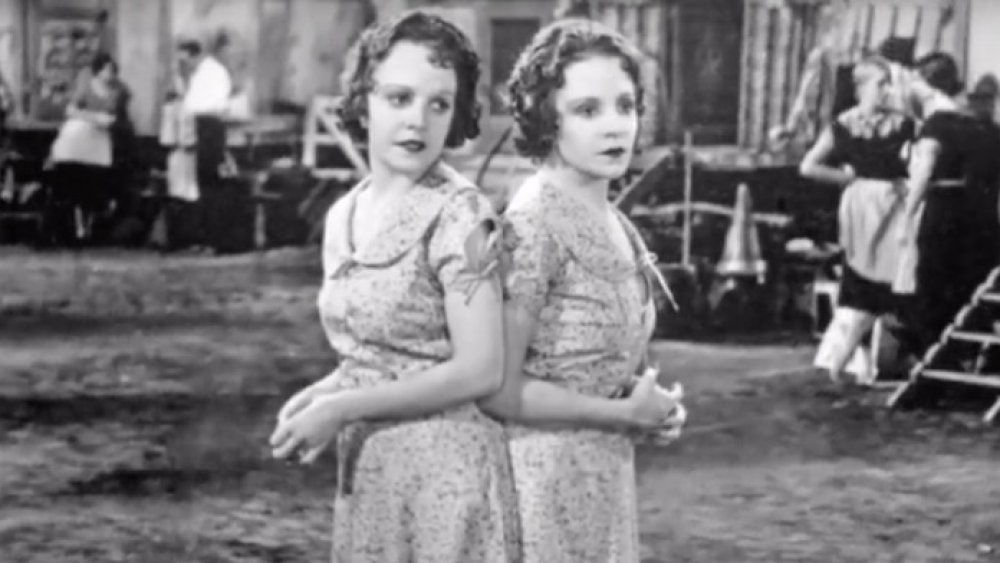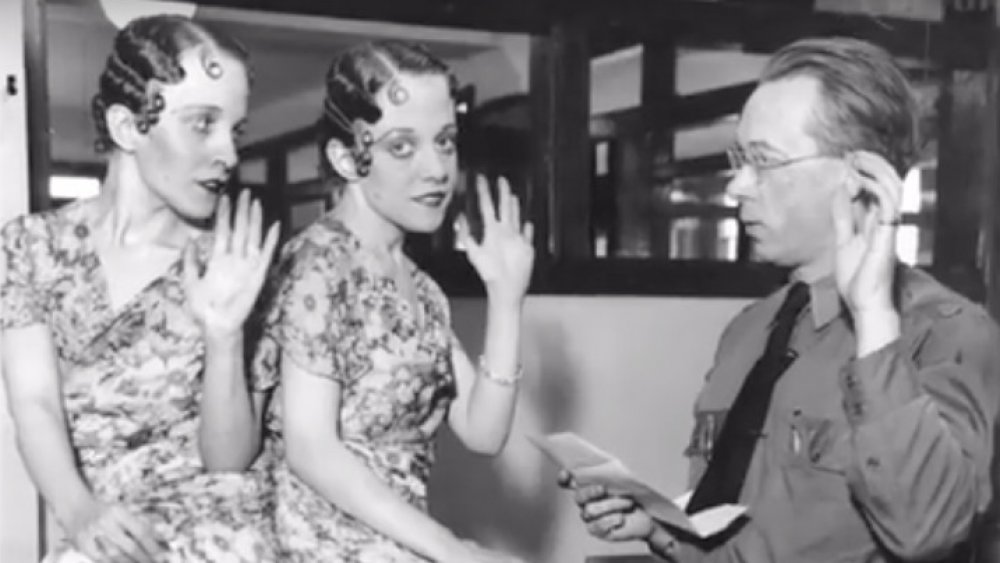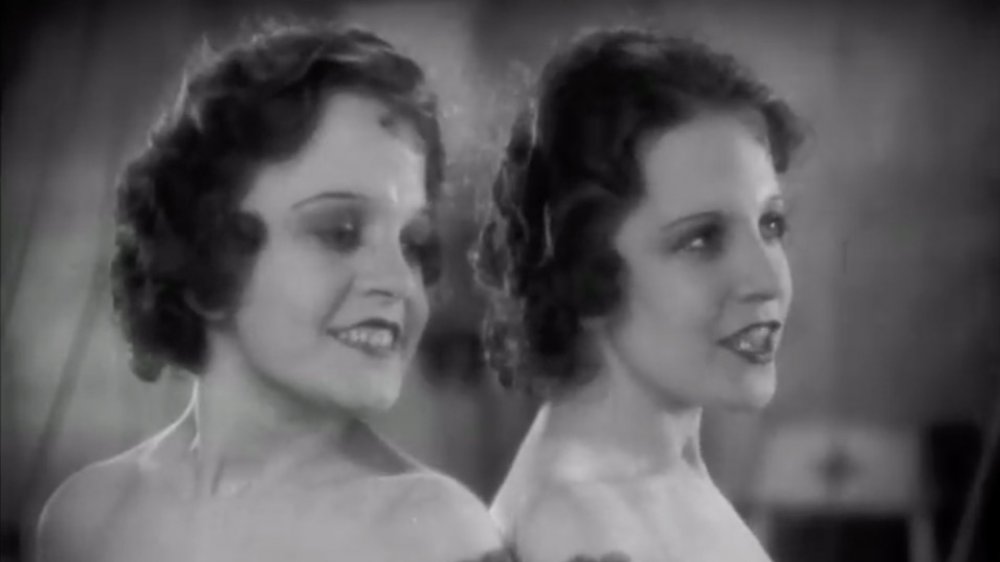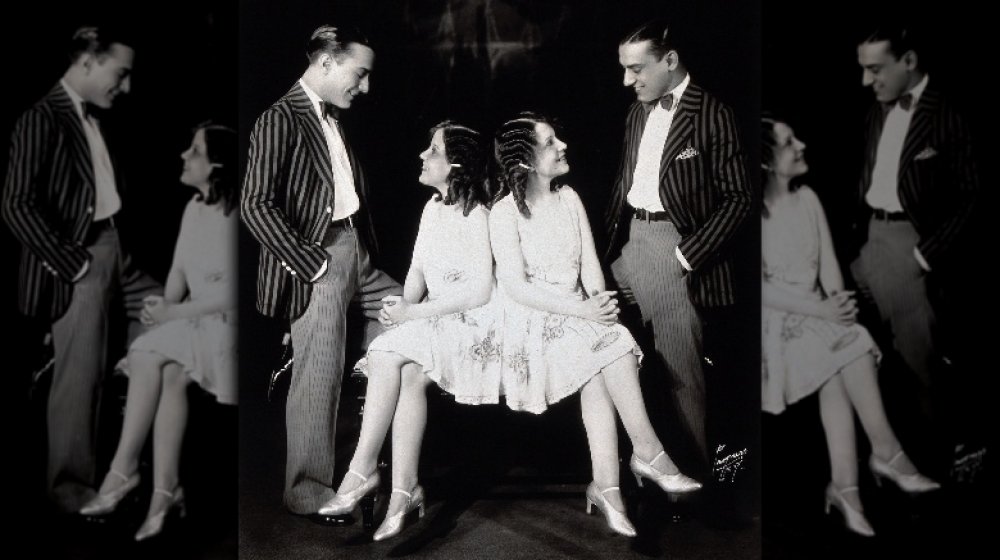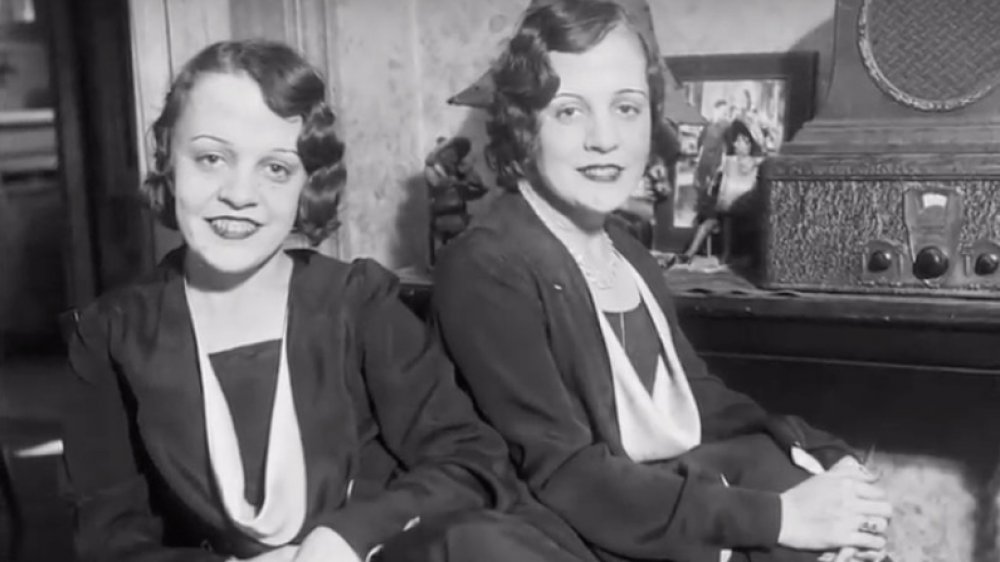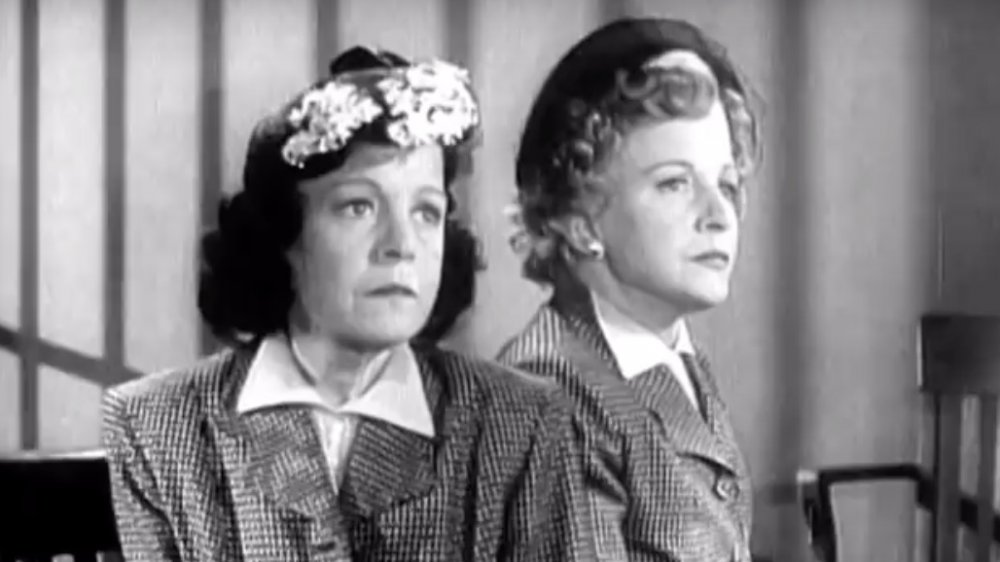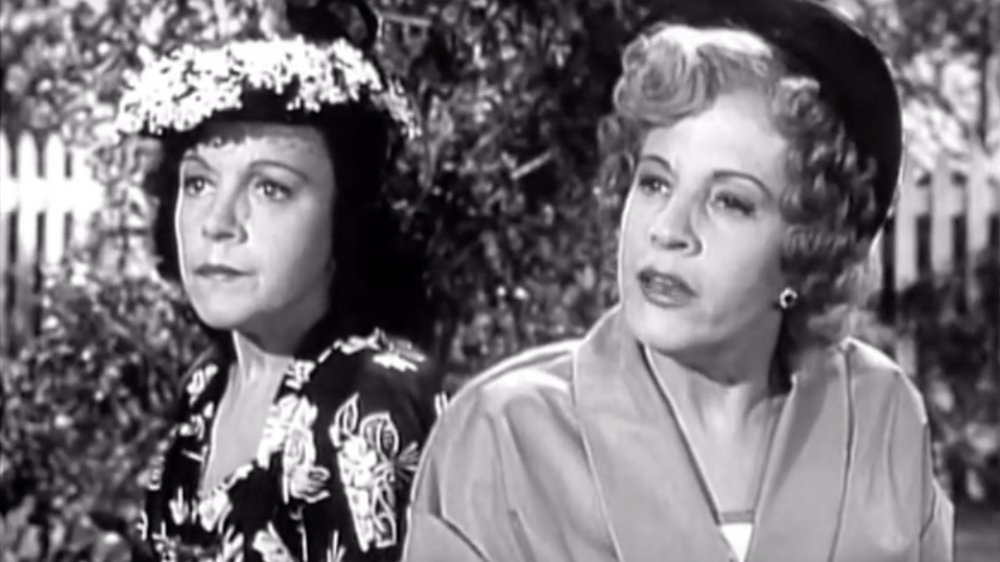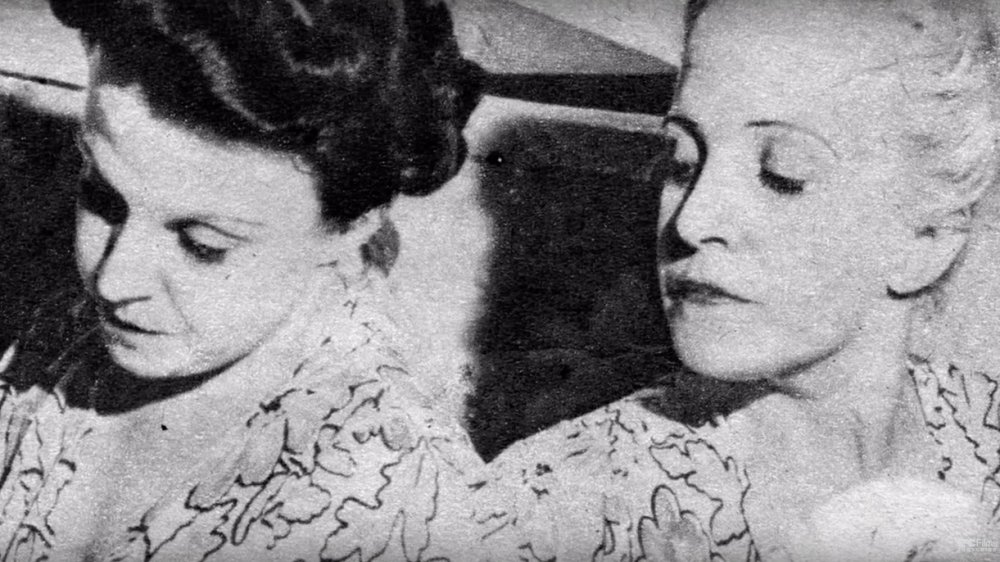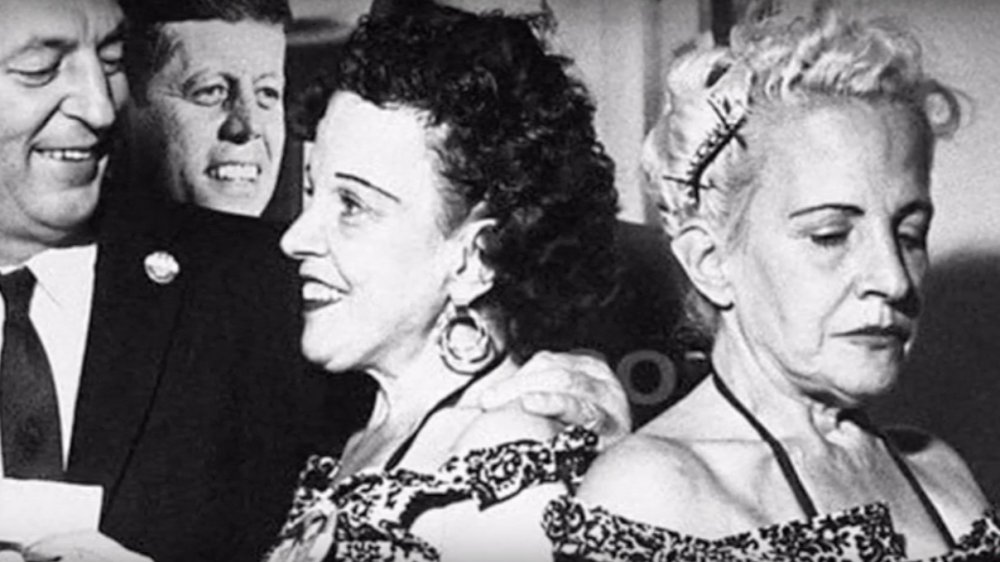The Untold Truth Of The Conjoined Hilton Sisters
We don't do sideshows anymore. No, we have the internet now, where we can gawk at things in the privacy of our own homes, so no one will ever know how depraved and insensitive we actually are. But not so very long ago, people who were visibly different not only got gawked at in person, they were often put in circus tents so people could charge money for other people to come gawk at them. And the saddest truth about circus sideshow acts is that oftentimes, that was their only real prospect. People who were visibly different were otherwise unemployable, and if they wanted to eat, sometimes joining a circus was the best option they had.
One of the saddest cases of a circus sideshow act was that of the Hilton sisters — conjoined twins who were beautiful, talented, exploited, and eventually forgotten. This is the untold truth of the Hilton sisters' tragic lives.
The Hilton sisters' mother sold them to her boss
Daisy and Violet Hilton were pygopagus twins, which means they were back-to-back. According to a paper published by their physician in The British Medical Journal, the pair were attached by a "fleshy and cartilaginous" mass. The sisters shared a circulatory system, but otherwise had their own separate internal organs. Still, doctors were unsure of the risks of separating them, so elected not to try, especially since the prognosis for conjoined twins in 1908 was poor and they weren't expected to survive long anyway.
Daisy and Violet's biological mother was an unmarried barmaid named Kate Skinner, and their father was unknown. According to the Huffington Post, Skinner viewed them as punishment for her out-of-wedlock pregnancy, and she gave them to her employer, Mary Hilton, in exchange for money. Hilton viewed the transaction as a sale, and as far as she was concerned, she owned the twins from that moment forward.
The Hilton sisters' childhood consisted mostly of abuse and world travel
Hilton didn't have good intentions when she decided to take on the twins. She never saw them as anything but a business opportunity, and she didn't think of them as daughters. Instead, she put them on display in the back room of her tavern, collecting admission fees and selling postcards with their picture as souvenirs.
According to the Huffington Post, the girls called Hilton "Auntie," but there was no family bond between them. There wasn't even a decent employer/employee relationship — Hilton believed the girls were her property, and she treated them like slaves. They were physically and emotionally abused by Hilton and the parade of different men in her life, and by the age of three they had to endure a life on the road, where they were displayed at various carnivals and circuses. By the time they were four they were touring the world, and in 1915 Hilton tried to bring them to the United States. At first, U.S. officials were reluctant to admit them because they were "medically unfit," but Mary Hilton was as savvy as she was unkind, and she managed to work up the local media to the point where authorities felt pressured to let the girls into the country. They eventually ended up in San Francisco, where they became the wards of Hilton's biological daughter Edith and her partner, a balloon salesman with the ridiculous name "Myer Myers." Life didn't really improve for them after that.
The Hilton sisters were talented performers
Despite the mistreatment and initial poor prognosis, the twins grew up healthy. Their doctor noted that they were "bright and intelligent," and that fact didn't escape Mary Hilton, either, who realized that they might draw bigger crowds if they were performing rather than just sitting, which is what most "freaks" did in sideshow acts. According to Gizmodo, Hilton had the pair practice singing and learn to play musical instruments. She dressed them up in frilly outfits and adorned them with bows, and taught them routines designed to entertain the people who were gawking at them. It was kind of repulsively genius.
The sisters grew up to be very capable jazz musicians. They could sing and dance, too, and they might have had prosperous lifelong careers as performers except that their talent was always overshadowed by the fact that they were conjoined twins. For most of their lives, they were viewed as freaks first and people second, if people at all.
The Hilton sisters thought of themselves as someone else's property
One of the many tragedies of people who are brought up in abusive and exploitative circumstances is that they often don't realize that they're being abused and exploited. According to the Huffington Post, Daisy and Violet didn't acknowledge themselves as autonomous people, at least not until they were exposed to outside influences. When they first came under the guardianship of Edith and Myer Myers, the twins referred to the couple as their "owners." Edith and Myers appeared to have lived in constant fear that their "property" would realize that slavery wasn't actually legal anymore and then leave — the couple slept in the same room as the twins and would threaten them with institutionalization if they ever considered escape.
Myers was a smart businessman and also a villain. He's the guy who envisioned the twins as more than just sideshow freaks — his ambition was to see them on the vaudeville stage, which was real show business in those days. After Edith's death, Myers obtained custody of the girls and successfully marketed them in America, while at the same time keeping them completely out of the loop. They never saw their own contracts and they were forced to spend all their time practicing, which not only made them even more marketable, but also ensured that they remained more or less isolated from the rest of the world.
The Hilton sisters earned thousands of dollars a week and never saw any of it
By the 1920s, the twins were practically superstars. They were performing on the vaudeville stage with legends like Charlie Chaplin and Bob Hope, and they were earning profits of up to $5,000 a week, which is pretty awesome money even by today's standards. But none of the money they earned actually went in their own pockets. Myers kept it all, and flaunted it by building himself a mansion in San Antonio, Texas.
Myers couldn't keep them isolated forever, though. The nature of show business is that stars will eventually end up interacting with other stars, and when that happens, other stars will find out that there's something fishy going on with that guy Myers and the Hilton sisters. According to Gizmodo, Daisy and Violet were adults when they were befriended by Harry Houdini, who learned that the sisters were essentially broke while their stepfather/manager was living in obnoxious luxury. He advised the pair to get a lawyer. That might have been the first time that Daisy and Violet realized that they were people and not property.
The Hilton sisters' legal troubles eventually led to their freedom
Daisy and Violet had an advance agent named Bill Oliver, and their relationship with him may or may not have been completely platonic. In their autobiography, the twins claimed that the relationship was strictly professional, but Oliver's wife sure didn't seem to think so. According to the Biography of Daisy and Violet Hilton, Oliver's wife filed for divorce on the grounds that her husband was "spending too much time" with the twins, and she also filed a lawsuit against the Hiltons in the amount of $250,000. Daisy and Violet got a lawyer, and that was when the truth about their appalling situation finally came out. The lawyer was shocked that the twins — who were over the age of 21 and legal adults — were still tied to Myer Myers and essentially penniless, while he was living high on the hog.
With the help of their new lawyer, the twins were finally able to achieve separation — not from each other, but from their abusive relationship with the Myers. In 1931, Violet and Daisy became emancipated and got the equivalent of $80,000 for their troubles. Myers got to keep his mansion.
Then things got better for the Hilton sisters?
Imagine that you've spent your whole life believing that you were the property of someone else. Imagine having no money of your own and no decision-making power. Now imagine if, at the age of 23, a judge suddenly gave you freedom and $80,000. What would you do?
Once they were free, Violet and Daisy had no idea what to do with themselves. They had never learned to manage their own lives or their own money. According to the L.A. Times, life following emancipation was basically just a long string of bad deals. The twins knew nothing else but show business and tried to make their way alone in an often unforgiving industry. They became U.S. citizens, but unfortunately, that doesn't come with a financial planner and they were essentially left to their own devices. So they did what any naive kid would do when suddenly turned loose in the world with a bunch of money and no oversight. They partied. They entered into a series of bad deals with managers and entertainment companies and got involved in a number of high-profile relationships with celebrities. Their lives pretty much spiraled out of control, and fame was the only thing keeping them afloat.
On to Hollywood for the Hilton sisters
Performers aren't always content with the stage, and Daisy and Violet, like many of their contemporaries, had aspirations of appearing on the big screen. According to the Wisconsin State Journal, they landed roles in a film called Freaks the year after they were emancipated, and the roles were exactly as exploitative and cringeworthy as you probably guessed they were.
It was 1932, which means the movie was really just the film version of a circus sideshow, starring a handful of people with real disabilities — Johnny Eck, a circus sideshow performer who was born without the lower half of his body, Schlitzie, a "pinhead" who suffered from microcephaly, and several dwarfs.
The movie invited unabashed gawking just like the back room of the bar where Daisy and Violet had spent their early years. In the film, a woman marries a dwarf so she can collect his large inheritance, and Daisy and Violet were essentially subplots. Critics were predictably horrified, and the film was banned in several European countries, including the twins' home country of England.
The Hilton sisters' real love lives weren't that great, either
The truth about the twins' love life was somewhat less lurid than the movies but still pretty tragic. They dated but had difficulties remaining permanently attached to anyone, for obvious reasons. Violet dated a couple of musicians and a boxer before finally settling on a bandleader named Maurice Lambert. According to the Biography of Daisy and Violet Hilton, the couple even got engaged, but when they tried to apply for a marriage license they were refused "on moral grounds." So they tried again ... and again ... in 21 different states. Finally, the couple got lawyers to help and even that wasn't enough. The pair eventually split.
Two years later Violet and Daisy's agent announced that he'd found a way to arrange for Violet to marry, but by then Lambert was long gone. So instead, she married her dance partner, James Walker Moore, but it didn't last. Daisy also got married to vaudeville dancer Harold Estep, but their marriage only lasted two weeks.
Daisy became a mother, but she gave her son up for adoption
The answer to your question is, "Yes." Daisy and Violet did experience romance in the fullest sense of the word. And since you're dying to know how that works, well, according to NPR, when you're a conjoined twin you kind of have to learn how to disconnect yourself from reality on occasion. "[It's] called 'alternate mastery,'" said Yunte Huang, who wrote a biography of conjoined twins Chang and Eng Bunker. "They basically propagated this notion or this skill which is that when — if Daisy, let's say, is dating or having sex with a man, Violet, the other twin, will basically do this kind of mental blank-out. She will either take a nap or read a book."
You'll be unsurprised to hear that there were consequences to the twins' romantic lives. According to The Lives and Loves of Daisy and Violet Hilton: A True Story of Conjoined Twins, Daisy became pregnant. The twins' agent tried to convince Daisy that her life was in danger and she should therefore have an abortion, with abortions in those days being illegal except to save the life of the mother.
The doctor's conclusion, though, was that Daisy's life was not in danger, so her pregnancy was allowed to continue. But times being what they were, Daisy gave her son up at birth and the twins are said to have never talked about the child again.
"Chained for Life" was a flop
By the late 1940s vaudeville was over and Daisy and Violent found themselves in a desperate situation. They were no longer in demand, and the public was starting to forget them. But then in 1950 they got what looked like it could be a second chance — a starring role in Chained for Life, a film about all the terrible things that can happen when conjoined twins try to have a love life. According to the Biography of Daisy and Violet Hilton, the story follows two vaudeville stars who seek separation so one of them can marry a man that the other one deeply dislikes. In the end, the not-engaged sister ends up murdering her twin's fiance, which poses an interesting moral question — do you send the guilty twin to jail and thus also condemn her innocent sister to a life prison sentence, or do you let the guilty twin free so as not to unfairly incarcerate an innocent woman?
Unfortunately, interesting moral questions don't always save films, and Chained for Life was a flop. It was also banned in a lot of venues because of its subject matter, and the Hiltons had to go elsewhere to support themselves.
The hot dog stand didn't pan out, either
After the failure of their second movie, things just continued to get worse. The twins could no longer find employment in the entertainment industry, and during their heyday, they hadn't exactly been frugal with their money. They weren't out of ideas yet, though. In the mid-1950s, the duo opened a hot dog stand in Miami and called it "The Hilton Sister's Snack Bar." Kudos to them for nurturing that entrepreneurial spirit.
At first, it seemed like the snack bar was the answer to the twins' woes. According to The Lives and Loves of Daisy and Violet Hilton: A True Story of Conjoined Twins, the hot dog stand was "swarming four and five deep with customers" on opening day. The optimistic twins told reporters they hoped the hot dog stand would just be a stepping stone into the restaurant business. "Next we want to get our own club on the beach," Violet told reporters.
The twins ran the stand from morning to evening seven days a week. But once the novelty wore off, business started to trail off, and the menu wasn't enough to keep customers coming back. According to some sources, neighboring vendors weren't happy about being overshadowed by a pair of "freaks," either, and within a year the sisters had to close their hot dog stand. So much for that entrepreneurial spirit.
Desperation sets in for the Hilton sisters
The twins struggled after that. They tried selling makeup door-to-door, but many people refused to let them inside because of their appearance. They got jobs as "The World's Only Strip-Teasing Siamese Twins," appearing in dive bars in front of patrons who mostly just wanted to laugh at them. According to the Biography of Daisy and Violet Hilton, by 1962 the twins had pinned their hopes on a cult revival of the movie Freaks. They even appeared at a drive-in movie theater in Charlotte, North Carolina, but the agent they'd hired to help them in their comeback aspirations abandoned them and took all of their earnings.
After that, Violet and Daisy only survived because of charity. A motel owner who was also a restaurateur offered them a free place to stay and three meals a day. The owners of a grocery store gave them jobs as produce weighers. They were also offered a place to stay by the elders of a nearby church. It wasn't exactly the glamorous life and show business comeback they'd hoped for, but they were finally comfortable. They continued to work at the grocery store for seven years.
The end finally comes for the Hilton sisters
In January of 1969, Daisy and Violet Hilton failed to report to work. After a day or two of trying to reach them by phone, their employers got the police to break into their home, where they were found dead, victims of the Hong Kong flu. Daisy died first, and the coroner concluded that Violet lived for two to four days afterward, though that is actually really unlikely. The twins shared a circulatory system, so Violet would have bled to death long before that much time had passed.
The twins were buried at Forest Lawn Cemetery in Charlotte, but with just $1,000 to their name, there wasn't enough money to buy their own cemetery plot, so they had to share one with the son of an acquaintance, a Vietnam soldier named Troy Thompson. According to the Charlotte Observer, the twins had a quiet funeral with friends and co-workers. And that was the end of the sad, strange (but kind of okay, in the end), lives of Daisy and Violet Hilton.
